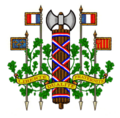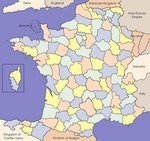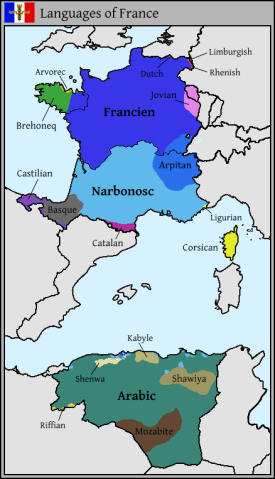France
| National motto: Liberté, Dualité, Fraternité. | |
| Languages | |
| Official | Francien, Narbonosc |
| Other | Brehonecq, Euskaran, Arvorec, Jovian |
| Capital | Paris |
| Important Cities | Toulouse, Lyons, Marseille |
| President | Emmanuel Caron |
| Prime Minister | Philippe Edouard |
| Area | ... |
| Population | 110,469,832 (2024 estimate) |
| Currency | 1 Livre = 20 sous = 240 deniers (Francie) 1 Livre = 20 soles = 240 denares (Gaulhe) |
| Organizations | Union des Pays Francophones |
The New French Republic or France (French: Nouvelle République Française or France) is a country whose metropolitan territory is located in western Europe, and which is further made up of a collection of overseas islands and territories.
France is a Federal Government, popularly referred to as the New Republic. While there are two major linguistic-ethnic groups, both feel they are equally French and part of the same country, although the Gaulhòscs of southern France and the Franciens of northern France feel they are strongly Gaulhòsc and Francien first, and French secondly, and this feeling usually surfacing only on matters of national pride. It should be noted that not all northern French consider themselves "Franciens", as this term applies specifically to the Ile de France region around Paris: the Walloons and Bretagnes in particular disavow the term "Francien" entirely, while the Normands are less fickle about the term.
France is a democracy organised as vertically centralised semi-presidential republic. It is a developed nation whose modern economy is the fifth-largest in the world in 2003. Its main values are expressed in the Declaration of the Rights of Man and of the Citizen.
Administration
Government
Under the constitution, the president is elected directly for a 5-year (originally 7-year) term. Presidential arbitration assures regular functioning of the public powers and the continuity of the state. The president names the prime minister, commands the armed forces, and concludes treaties.
Secretaries of State (secrétaires d'état) and Ministers (ministres) form the council of state (conseil d'état) which is chaired by the prime minister (premier ministre). The Ministers head the major departments (navy, foreign affairs, etc...) and the Secretaries of State head the smaller departments (sports, old age, etc...). While there can be any number of secretaries of state, ministers are limited to 15, 7 of which must come from each of the major communities.
The National Assembly (Assemblée Nationale) is the principal legislative body. Its deputies are directly elected to 5-year terms, and all seats are voted on in each election. Ministers have no seats (i.e., they must renounce any seat held). The Assembly has the power to dismiss the council of state (through a motion of non-confidence), and thus the majority in the Assembly determines the choices of government. Since politcal parties tend to be more popular in one community or another, the governments have always been coalitions and the weight of the various parties tends to be reflected in the composition of the council of state.
Senators are chosen by an electoral college for 6-year terms, and one half of the Senate is renewed every 3 years. A measure adopted at the time of the creation of the communities stipulates that a certain number of senators (based on population) must come from gaulhosc departments. The Senate's legislative powers are limited; the National Assembly has the last word in the event of a disagreement between the two houses, excepting constitutional laws (amendments to the constitution & lois organiques). The government has a strong influence in shaping the agenda of Parliament.
French politics for the past 30 years have been characterised by the opposition of two political groups: one left-wing, centred around the French Socialist Party, and one right-wing, centred around the RPR, then its successor the UMP (now Les Républicains). The Front National, a far-right Ultrarepublican party advocating tougher law-and-order and immigration policies, has made inroads since the early 1980s and seems to remain stable at around 16% of the votes and then, only in Francie. The Front's political enemy in Gaulh is the far-right separatist Bloque Gaulhòsc.
Political Parties
As most parliamentary countries, France has a large number of political parties, covering the wide range of the political spectrum. In recent decades there has been a growing trend for parties to group together in coalitions for elections, extending the coalition-forming tendency from the halls of government to the election path.
For further information, see Political Parties of France.
Elections
The Elections of 2007 drew significant attention both nationally and internationally, as Ségolène Royal, Nicolas Sarkozy and a possible bid for a third-term by incumbent Jacques Chirac, which has hence been refuted by Chirac. Politicking was hot and furious in France as nearly 20 candidates vied for two slots in the secondary voting.
Subnational Entities
France is divided into Communities, Departments, prefectures/sub-prefectures and cantons.
Communites
Communites (fr:communautés) are grouping of departments based either on ethnicity (Francie, Gaulh) or geography (Oversea departments). Apart from the overseas one, the communities have an elected representative body headed by the Minister-in-chief (Ministre en chef). Although devoid of a single representative assembly, oversea departments vote for their own prefect (see below). It should be noted that the communities are a recent development dating only from the 1950s, and although answering to a demand from Gaulosc for decentralisation, it has caused much friction with the federalists of Francie.
List of Communities:
- Francie: Is composed of the departements in the north-western part of metropolitan France.
- Gaulh: Is composed of the departements in the south-eastern part of Metropolitan France.
- Algeria maintains a large degree of autonomy, but is nominally subject to Gaulh.
- Overseas (Outremer): Is composed of all the departements outside of Metropolitan France.
For a complete explanation about the true status of Bretagne (Brehun), see Brehun.
Provinces
Les Provinces, while "eradicated" by the revolution were re-instated under Napoleon, and act as a middle level division to the national communautés. The borders were somewhat adjusted following the creation of the départements, however, they are largely unchanged from their historical state. These are touristic divisions, mostly, recognized by the state, but having no political or legal ramifications except for Bretagne.
List of Provinces
● 1. Nord-Pas de Calais ● 2. Waloonie ● 3. Picardie ● 4. Champagne ● 5. Lorraine ● 6. Franche-Comté ● 7. Bourgogne ● 8. Berry-Nivernais ● 9. Orléanais ● 10. Île-de-France ● 11. Normandie ● 12. Bretagne ● 13. Maine-Anjou ● 14. Poitou-Garonne ● 15. Marche-Limousin ● 16. Auvergne ● 17. Lyonnais ● 18. Dauphiné-Savoie ● 19. Provence ● 20. Languedoc ● 21. Rousillion-Foix ● 22. Aquitaine ● 23. Navarre ●
Departments
Departments are administrative division headed by a prefect (préfet). This person is an elected civil servant (except in oversea departments where is is elected directly by residents) and is seconded (where aplicable) by a varying number of sub-prefects (sous-préfets), each heading his own sub-prefecture (sous-préfecture). Most citizens of France know each department by its assigned number.
List of Departments (pending review):
Francian Departments
● Aisne ● Ardennes ● Aube ● Brôu Vannès ● Calvados ● Charente ● Charente-Maritime ● Cher ● Côte-d'Or ● Cornouaille ● Deux-Sèvres ● Domnonie ● Doubs ● Essonne ● Eure ● Eure-et-Loir ● Hainaut: Divided into the Mons prefecture and 6 sub-prefectures ● Haute-Marne ● Haute-Saône ● Hauts-de-Seine ● Ille-et-Vilaine ● Indre ● Indre-et-Loire ● Jura ● Liege: Divided into the Liege prefecture and 3 sub-prefectures ● Loire-Atlantique ● Loiret ● Loir-et-Cher ● Léon ● Maine-et-Loire ● Manche ● Marne ● Mayenne ● Meurthe-et-Moselle ● Moselle ● Namur: Divided into the Namur prefecture and 2 sub-prefectures ● Nièvre ● Nord ● Oise ● Orne ● Paris ● Pas-de-Calais ● Saône-et-Loire ● Sarthe ● Seine-et-Marne ● Seine-Maritime ● Seine-Saint-Denis ● Somme ● Territoire-de-Belfort ● Val-de-Marne ● Val-d'Oise ● Vendée ● Vienne ● Vosges ● Walloon Brabant: composed only of the Wavre prefecture ● Yonne ● Yvelines ●
Gaulhòsc Departments
● Ain ● Álava ● Allier ● Alpes-de-Haute-Provence ● Alpes-Maritimes ● Ante-Pyrenee ● Ardèche ● Ariège ● Aude ● Aveyron ● Bouches-du-Rhône ● Cantabria ● Cantal ● Corrèye ● Corse-du-Sud ● Creuse ● Dordogne ● Drôme ● Gard ● Gers ● Gironde ● Guipúzcoa ● Haute-Corse ● Haute-Garonne ● Haute-Loire ● Hautes-Alpes ● Haute-Savoie ● Hautes-Pyrénées ● Haute-Vienne ● Hérault ● Isère ● Landes ● Loire ● Lot ● Lot-et-Garonne ● Lozère ● Puy-de-Dôme ● Pyrénées-Atlantiques ● Pyrénées-Orientales ● Rhône ● Savoie ● Tarn ● Tarn-et-Garonne ● Var ● Vaucluse ● Vizcaya ●
Algerien Departments
These departments are counted in the total number of Gaul, but are administered autonomously within Algeria.
Overseas departments
● Austro-Antartica ● French Guyana ● French Polynesia ● Guadeloupe ● Martinique ● Mayotte ● New-Caledonia ● Réunion ● Saint-Pierre-et-Miquelon ● Wallis-et-Futuna ●
Condominiums
● Meuse ●
Prefectures/Sub-Prefectures
Departments are further divided in one prefecture (the largest city and where the prefet reside) and some sub-prefectures (headed by sub-prefects) the number of which depend on the size of the department.
Canton
The smallest subnational entity, the canton represent a small region joined for stricly administrative purpose. There is no central body governing the canton but rather a number of organisation providing joint services (fire brigade, revenue, etc...).
History
See main page: History of France
Geography
France's geography varies between the high mountains of the Alps to the East and the volcanic Massif Central, to the rolling hills of the Côte d'Or, and the alluvial flood plains of the Garonne, the Seine and the Loire.
Among the most beautiful countryside is the Ardêche, near Avignon. Tourists flock to this region of Gaulhe in droves.
Borders
- North: the British Sea, Batavian Kingdom.
- West: the Atlantic Ocean.
- South: Castile and Leon, Aragon, Andorra, Monaco, the Mediterranean.
- East: the Holy Roman Empire, Jervaine, Helvetia, Grand Fenwick, the Italian states.
- France entirely surrounds Saugeais.
Economy
France’s industry is largely sufficient for its own needs, with the car manufacturers of Peugeot, Renault and Citroën providing motor vehicles to the country, Michelin providing the tires. France maintains the SNCF, or Société Nationale des Chemins de Fer, a national rail system, and many other industrial ends. France’s main exports are luxury items, such as wines, cheeses and chocolate.
Despite the availability of Tesla Generators France has staunchly remained a champion of civil nuclear power. [1]
France is also well known for its airplane manufacturer Avions Dassault-Breguet, makers of jet airplanes and zeppelin turbines.
Culture
Under the Republic, France offers education for free to all from the age of 2, mandatory from 6 to 16. This continues in the fine tradition started by the founding of the University of Paris in 1150.
While there is a a federal government, and both Gaulhóscs and Franciens feel they are French and part of the same country, one must be aware that Gaulhóscs are strongly Gaulhósc and Franciens strongly Francien first, and being French is a secondary concern (usually only when the national football team is playing). The minority groups of Bretons, Basques and Walloons are much the same although due to their small number, have so far failed to gained political representation or cultural protection.
Languages
The French are proud of their nation's languages, sponsoring them through administrative autonomy by linguistic division. Notable divisions of the country are, of course, Francien and Narbonosc but recent initiative has helped the promotion of Euskara and Brehonecq as well. Euskara is the largest of the minority languages, a notable third after Francien and Gaulhósc. Brehonecq comes in fourth place.
Religion
Religion has been a tricky topic in France since the 1500's when the Huguenots and Catholics fought one another. As almost a part of communal pride, Gaulhe is very staunchly diverse, religiously, whereas Francie is more staunchly Roman Rite Catholic. There are several Guisian strongholds where Catholicism is strong around Toulouse and Avignon, however, the Church "membership" across Gaulhe is nearly equally divided between the Catholics and the Protestants. France's total population is 15% Huguenot (16,570,476 people as of 2024), but that population is disproportionately found in Gaulhe, although pockets of Reformed Protestantism can be found around Caen, Orléans, Ivry, Île-de-France, La Rochelle, Normandy, and Picardy. The city of Algiers even has a robust Huguenot community as well assimilated Helvetian and German Reformed immigrants dating back to the first decade of the 20th Century. France undoubtedly has the largest Reformed Protestant (Calvinist) population in Europe, if not the world.
Secession Movements
France, like many nations has internal agitation for germanization. Due to the general sense of laissez-faire between the Francien and Algerien Communautés, however, there is a great degree of autonomy for the different regions, and those movements that do exist are largely small. Current active movements include:
Violent Movements:
Political Movements:
- Ligue Bourgignon
- Parti pour l'Organisation d'une Bretagne Libre
| |||
|---|---|---|---|
| Communities | |||
| Francie | Gaullhe | DOM | Algeria* | | |||
| Départements | |||
| Ain | Aisne | Álava | Allier | Alpes-de-Haute-Provence | Alpes-Maritimes | Ante-Pyrenee | Ardèche | Ardennes | Ariège | Aube | Aude | Austro-Antartica | Aveyron | Bouches-du-Rhône | Calvados | Cantabria | Cantal | Charente | Charente-Maritime | Cher | Corrèye | Corse-du-Sud | Côte-d'Or | Côtes-d'Armor | Creuse | Deux-Sèvres | Dordogne | Doubs | Drôme | Essonne | Eure | Eure-et-Loir | Finistère | Gard | Gers | Gironde | Guipúzcoa | Hainaut | Haute-Corse | Haute-Garonne | Haute-Loire | Haute-Marne | Hautes-Alpes | Haute-Saône | Haute-Savoie | Hautes-Pyrénées | Haute-Vienne | Hauts-de-Seine | Hérault | Ille-et-Vilaine | Indre | Indre-et-Loire | Isère | Jura | Landes | Liege | Loire | Loire-Atlantique | Loiret | Loir-et-Cher | Lot | Lot-et-Garonne | Lozère | Maine-et-Loire | Manche | Marne | Martinique | Mayenne | Mayotte | Meurthe-et-Moselle | Meuse | Morbihan | Moselle | Namur | New-Caledonia | Nièvre | Nord | Oise | Orne | Paris | Pas-de-Calais | Puy-de-Dôme | Pyrénées-Atlantiques | Pyrénées-Orientales | Réunion | Rhône | Saint-Pierre-et-Miquelon | Saône-et-Loire | Sarthe | Savoie | Seine-et-Marne | Seine-Maritime | Seine-Saint-Denis | Somme | Tarn | Tarn-et-Garonne | Territoire-de-Belfort | Val-de-Marne | Val-d'Oise | Var | Vaucluse | Vendée | Vienne | Vizcaya | Vosges | Wallis-et-Futuna | Walloon Brabant | Yonne | Yvelines | |||
| Départements d'Outre-Mer | |||
| French Guyana | Guinée | Guadeloupe | Mélanasie Français | Nouvelle Calédonie | Polynesie Français | Vanuatu | |||
[DH, CG & MP]





